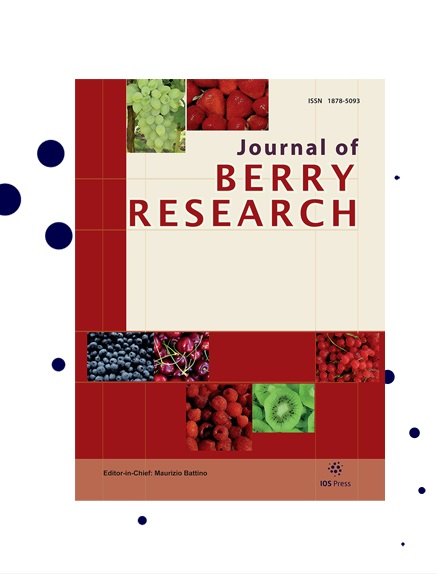赤霞珠不同肥料对葡萄香气积累的影响
IF 1.4
4区 农林科学
Q3 PLANT SCIENCES
引用次数: 1
摘要
背景:葡萄藤营养会影响葡萄的成分,但它如何影响葡萄的香气在很大程度上是未知的。目的:研究不同肥料:化肥(CF)、羊粪基有机肥(of)、50%有机肥+50%化肥(O + C) ,25%有机肥+25%化肥[1/2(O + C) ]和土壤调节剂(SC)对赤霞珠葡萄香气积累的影响。方法:2019年8月7日至9月22日,每周进行一次治疗并采集样本。对葡萄的化学特性和挥发性成分进行了分析。结果:化学结果表明,这些处理对葡萄有积极的影响,对1/2(O + C) 治疗。葡萄香气结果表明,O + C处理的样品低于其他处理。与包括对照(15.9%)在内的其他处理相比,OF处理的样品在成熟期的挥发性浓度相对较高(24.8%)。在整个发育过程中,用OF(17.4%)和CF(15.7%)处理的样品的挥发性浓度高于用SC(14.4%)、1/2(O + C) (12.8%)和O + C(12.4%)。然而,与SC处理的样品相比,用1/2(O)处理的样品 + C) 增加了萜烯和酯类的积累。主成分分析(PCA)结果表明,用OF处理的样品在成熟过程中与羰基、萜烯和酯类密切相关。结论:肥料的种类和配比对赤霞珠的香气有显著影响。本文章由计算机程序翻译,如有差异,请以英文原文为准。
Application of different fertilizers to cabernet sauvignon vines: Effects on grape aroma accumulation
BACKGROUND: Vine nutrition affects the composition of grapes, but how it impacts the aroma of grapes is largely unknown. OBJECTIVE: This work aimed to investigate the effect of different fertilizers: chemical fertilizer (CF), sheep manure-based organic fertilizer (OF), 50% organic fertilizer + 50% chemical fertilizer (O + C), 25% organic fertilizer + 25% chemical fertilizer [1/2(O + C)], and soil conditioner (SC) on the aroma accumulation of Cabernet Sauvignon grapes. METHODS: The treatments were applied and samples were collected in 2019 at weekly intervals from August 7 to September 22. The grapes’ chemical characteristics and volatile compounds were analyzed. RESULTS: The chemical results showed that the treatments had a positive effect on grapes, with a strong preference for the 1/2(O + C) treatment. Grape aroma results showed that the concentrations of grape aromas in O + C-treated samples were lower than the other treatments. The OF treated samples had comparatively high (24.8%) volatile concentrations during maturity compared to other treatments, including the control (15.9%). Throughout development, samples treated with OF (17.4%) and CF (15.7%) had higher volatile concentrations than samples treated with SC (14.4%), 1/2(O + C) (12.8%), and O + C (12.4%). However, compared to SC-treated samples, samples treated with 1/2(O + C) increased the accumulation of terpenes and esters. The principal component analysis (PCA) results showed that samples treated with OF were strongly correlated to carbonyls, terpenes, and esters during maturity. CONCLUSION: The type and ratio of fertilizer used had a significant impact on the aroma profile of Cabernet Sauvignon grapes.
求助全文
通过发布文献求助,成功后即可免费获取论文全文。
去求助
来源期刊

Journal of Berry Research
Biochemistry, Genetics and Molecular Biology-Biochemistry
CiteScore
3.50
自引率
11.80%
发文量
21
期刊介绍:
The main objective of the Journal of Berry Research is to improve the knowledge about quality and production of berries to benefit health of the consumers and maintain profitable production using sustainable systems. The objective will be achieved by focusing on four main areas of research and development:
From genetics to variety evaluation
Nursery production systems and plant quality control
Plant physiology, biochemistry and molecular biology, as well as cultural management
Health for the consumer: components and factors affecting berries'' nutritional value
Specifically, the journal will cover berries (strawberry, raspberry, blackberry, blueberry, cranberry currants, etc.), as well as grapes and small soft fruit in general (e.g., kiwi fruit). It will publish research results covering all areas of plant breeding, including plant genetics, genomics, functional genomics, proteomics and metabolomics, plant physiology, plant pathology and plant development, as well as results dealing with the chemistry and biochemistry of bioactive compounds contained in such fruits and their possible role in human health. Contributions detailing possible pharmacological, medical or therapeutic use or dietary significance will be welcomed in addition to studies regarding biosafety issues of genetically modified plants.
 求助内容:
求助内容: 应助结果提醒方式:
应助结果提醒方式:


